The mental health consequences of single disasters for most people include mild stress and insomnia, high-risk coping behavior such as increased alcohol use, and mental disorders such as depression, anxiety and post-traumatic stress. Climate-related increase in global temperatures affects populations via circumscribed localized disasters, but also via long-term and often large-scale effects that come from experiencing repeated disasters and their effects on well-being, economic stability and infrastructure in a given region. This might include cumulative community stress, increases in poverty domestic violence and substance abuse and forced migration. Flooding and prolonged droughts have also been associated with mental health conditions like elevated levels of anxiety, depression, suicide, and post-traumatic stress disorders (U.S. GCRP).

Children are more affected by disasters than adults and are more likely to have continued trauma-related symptoms after a disaster (Lancet Commission). Disruptions in routine, separation from caregivers as a result of evacuations or displacement, and parental stress after a disaster all contribute to children’s distress. Children are often very resilient and reactions to disasters may resolve over time, but they should be monitored for long-term effects of chronic stress.
First responders, emergency workers and others involved with responding to extreme weather-related disasters are at increased risk for mental health consequences both in the short and long term (US GCRP). These individuals may be both a responder and victim, required to provide care for the public while managing the adverse impacts of a disaster for their own family. Responders and emergency workers are often exposed to injury or death in the line of work, which can increase negative impacts.
There are steps you can take to better prepare for disasters and to help yourself and your family when they do occur. These include training on safe evacuation from disasters of different kinds, preparing a “go bag” with important documents, treasured memorabilia and safety needs such as flashlights, solar batteries, and matches, and keeping your car and home stocked with a several-day supply of water and non-perishable food.
Heat Impacts on Mental Health
Heat has direct effects on human health, including causing heat illnesses such as heat exhaustion and heat stroke and medical complications of heat, including more strokes and heart attacks. Human beings cannot tolerate temperatures over 108°F for long without significant acclimatization, and prolonged heat waves, particularly if they occur in populations ill-prepared to manage them, can cause large numbers of deaths. People with mental illness do not tolerate heat as well as others because of the chemistry of their illness. Patients with psychiatric disorders are also at increased risk for heat illness and mortality from medications that prevent an optimal response to physiological heat stress (Sorensen).
At the population level, extreme heat has been associated with increases in aggressive behavior and domestic violence (USGCRP). Exposure to extreme heat may lead to increased use of alcohol to cope with stress, increases in hospital and emergency room admissions for people with mental health or psychiatric conditions, and an increase in suicide (Dumont). By one estimate, an increase of 1 to 6 degrees Celsius could result in an additional 283 to 1,660 suicide cases (0.7% and 4.1%) in the United States (Belova). Uncomfortably high temperatures also increase negative emotions in the population (Baylis).
Nutritional Impacts of climate change
The droughts, floods and changing habitats of climate change lead to a net decrease the global food supply: approximately 1% for every degree Celsius mean temperature increase. Plants also grow faster in higher temperatures and more CO2 and have less time to absorb nutrients that are important for brain health, particularly zinc and iron (Beach). Children with inadequate food have poorer cognitive development and more mental health diagnoses. Zinc deficiency is strongly associated with depression and psychosis, (Petrilli) and iron deficiency has been associated with bipolar disorder.
Particulate Air Pollution and Mental Health
Air pollution derives from numerous sources, but 85 percent of air pollution is derived from fossil fuel use. This particulate air pollution can travel to the brain in the blood vessels and in nerve cells, where it causes inflammatory cell damage. Air pollution has been shown to increase the risk of autism, lower cognitive ability and cause more ADHD and behavioral problems in children, and to increase the risk of dementia, particularly Alzheimer’s dementia, in adults. It also increases the risks of depression, suicide, Parkinson’s disease, and possibly psychosis. Forrest fires contribute to this particular pollution and can also carry other environmental pollutants from burning structures (Peeples).
Infectious Disease Impacts of climate change
Finally, climate change leads to major shifts in the geographical distribution of human pathogens, particularly vector-borne illnesses hitherto unknown or rare in the United States (Mora). Diseases such as Lyme, Powassan, malaria and others are spreading to new habitats and surviving through more of the year. Bats carry diseases that survive in higher temperatures, placing them at greater likelihood of environmental transmission. These infections can result in psychiatric symptoms when the brain is affected.
Physician review:
Elizabeth Haase, M.D.
May 2023
